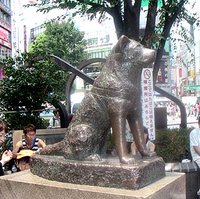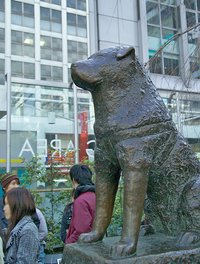 Statue of Hachiko in
Shibuya
Statue of Hachiko in
Shibuya
|
From Wikipedia the free encyclopedia, by MultiMedia |
 The statue of Hachiko is a favorite meeting spot in
Tokyo.
The statue of Hachiko is a favorite meeting spot in
Tokyo.
 Statue of Hachiko in
Shibuya
Statue of Hachiko in
Shibuya
Hachikō, sometimes known in Japanese as 忠犬ハチ公 (chūken hachikō, lit. 'faithful Dog Hachiko'), was an Akita Dog born in November, 1923, in the city of Odate, Akita Prefecture. In 1924 he was brought to Tokyo by his owner, Eisaburo Ueno, a professor in the agriculture department at the University of Tokyo. During his owner's life, Hachiko saw him off from the front door and greeted him at the end of the day at the nearby Shibuya Station. Even after Ueno's death in May, 1925, Hachiko returned every day to the station to wait for him, and did so for the next eleven years.
Affection between the professor and the Dog was immediate. The professor named the pup "Hachi" and added "ko", a common term of endearment. For his part, Hachi-ko accompanied the professor everywhere he could. As he grew, Hachi-ko took on the traditional traits of an Akita; his ears stood upright, and his tail curled up and to the left. Professor Ueno reportedly took great pride in owning a purebred Dog of a breed that had a history going back thirty centuries -- especially as the number of purebred Akitas in Japan was dwindling at the time.
When the professor died, Mrs. Ueno closed the house and moved, giving Hachiko to some of her husband's relatives who lived several miles from the station. The Akita refused to stay with them. As soon as he was let out, he trotted back first to his old house, then to the train station to await his master. Professor Ueno's gardener, Kikuzaburo Kobayashi, lived close to the station and took over Hachiko's care.
Hachiko's devotion to his lost master moved those around him, who nicknamed him "faithful Dog," though some speculate that he kept returning because of the handouts he received from street vendors (upon his death, an autopsy revealed remnants of what were apparently yakitori skewers in his stomach).
In the first years of his vigil, Hachiko was treated as little more than a tolerable nuisance at the train station. In 1928, a new station master came to Shibuya Station. He quickly grew very fond of him and allowed him free run of the facility. Hachiko still kept his schedule, but also was allowed to remain in the station throughout the day, sleeping in a storeroom set aside for him by the new station master.
That same year, another of Professor Ueno's former students (who had become something of an expert on Akitas), saw the Dog at the station and followed him to the Kobayashi home where he learned the history of Hachiko's life. Shortly after this meeting, the former student published a documented census of Akitas in Japan. His research found only thirty purebred Akitas remaining, including Hachiko from the Shibuya station.
Professor Ueno's former student returned frequently to visit the Dog and over the years published several articles about Hachiko's remarkable loyalty. In 1932 one of these articles, published in Tokyo's largest newspaper, threw the Dog into the national spotlight. Hachiko became a sensation throughout the land. His faithfulness to his master's memory impressed the people of Japan as a spirit of family loyalty all should strive to achieve (or rather as propaganda for the government; Japan was at war with China at that time). Teachers and parents used Hachiko's vigil as an example for children to follow. A well-known Japanese artist rendered a sculpture of the Dog, and throughout the country a new awareness of the Akita breed grew.
In April, 1934, a bronze statue in his likeness was erected at Shibuya Station, and Hachiko himself was present at its unveiling. The statue was recycled for the war effort during World War II. After the war, Hachiko was hardly forgotten. In 1948 The Society For Recreating The Hachiko Statue commissioned Ando Tekeshi, son of the original artist who had since passed away, to make a second statue. The new statue was erected in August, 1947, which still stands and is an extremely popular meeting spot. A similar statue stands in Hachiko's hometown, in front of Odate Station.
Hachiko died in March 1935 of filariasis. His stuffed and mounted remains are kept at the National Science Museum in Ueno, Tokyo.
Hachiko was the subject of the 1987 movie Hachiko Monogatari.
The story may also have influenced the Futurama episode Jurassic Bark.
Dogs, made by MultiMedia | Free content and software
This guide is licensed under the GNU Free Documentation License. It uses material from the Wikipedia.